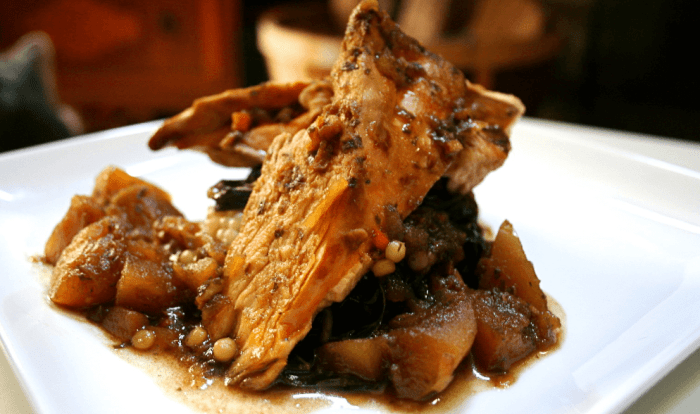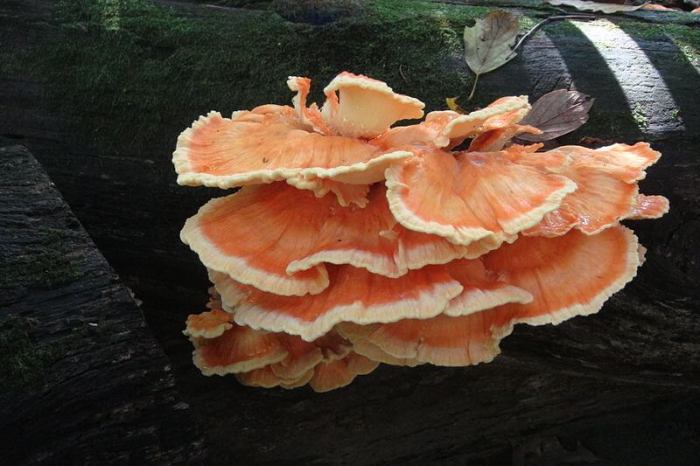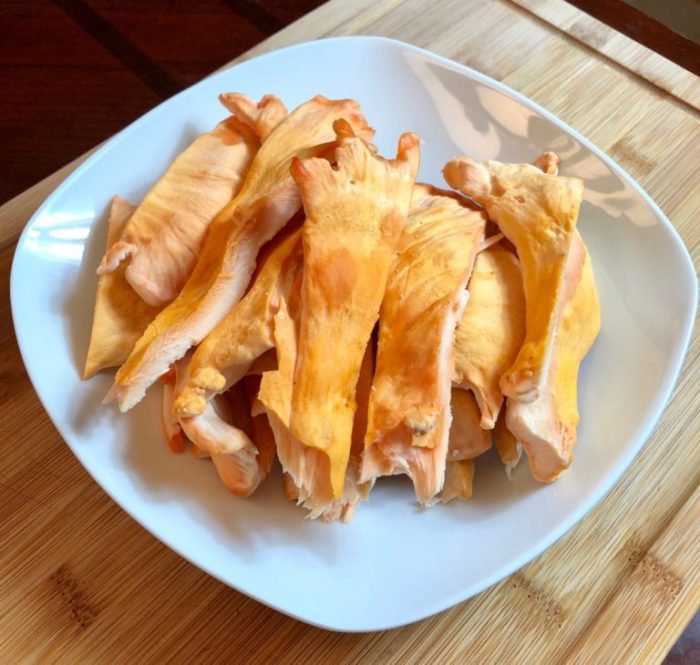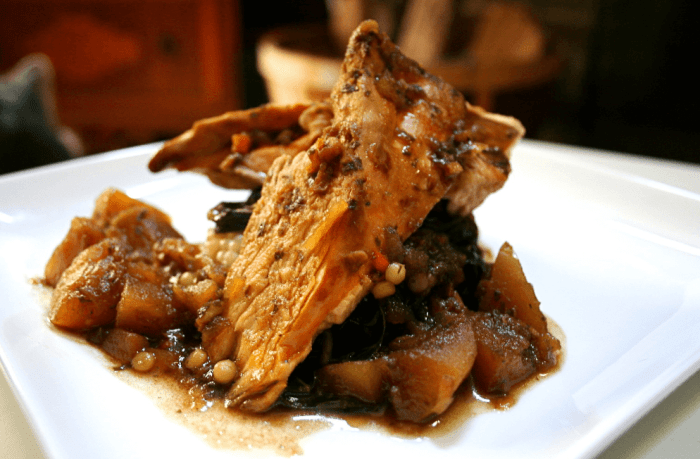
As the Chicken of the Woods Recipe takes center stage, this opening passage beckons readers into a world crafted with good knowledge, ensuring a reading experience that is both absorbing and distinctly original.
Prepare to embark on a culinary journey that explores the diverse cooking methods, global culinary applications, and potential health benefits of this remarkable mushroom. Whether you’re a seasoned chef or a curious home cook, this comprehensive guide will provide you with the inspiration and knowledge to create mouthwatering dishes that showcase the unique flavors and textures of Chicken of the Woods.
Introduction to Chicken of the Woods

Chicken of the Woods, also known as Laetiporus sulphureus, is a vibrant and distinctive edible mushroom. Its unique appearance and culinary versatility have made it a popular choice among foragers and mushroom enthusiasts alike.
If you’re looking for a vegan alternative to chicken, try this chicken of the woods recipe . This mushroom has a similar texture to chicken and can be used in a variety of dishes. Whether you’re making a stir-fry, a soup, or a stew, this recipe will give you a delicious and satisfying meal.
Chicken of the Woods is characterized by its bright orange to yellow coloration, which can vary in intensity. It typically grows in clusters on the trunks of dead or dying hardwood trees, particularly oak and maple. Its flesh is tender and juicy, with a mild flavor that is often compared to chicken, hence its common name.
Nutritional Value, Chicken of the woods recipe
Chicken of the Woods is not only visually appealing but also nutritionally beneficial. It is a good source of protein, fiber, and various vitamins and minerals, including vitamin C, potassium, and iron. Its antioxidant properties have also been recognized, making it a valuable addition to a healthy diet.
Versatile Preparation Methods
Chicken of the Woods offers culinary versatility, allowing for diverse preparation methods that enhance its unique flavor and texture. From sautéing to roasting, grilling to pickling, each technique imparts distinct characteristics, catering to various preferences and culinary goals.
Sautéing, a quick and easy method, involves cooking the chicken in a pan with butter or oil. This method yields tender, juicy mushrooms with a slightly crispy exterior. Roasting, on the other hand, brings out the earthy flavors of Chicken of the Woods.
By roasting the mushrooms in the oven, they develop a caramelized crust and a rich, umami-packed interior.
Grilling
Grilling is an excellent method for infusing Chicken of the Woods with smoky flavors. When grilled over high heat, the mushrooms develop a charred exterior while retaining their moist and succulent interior. Grilling also allows for easy control over the level of charring, ensuring the desired texture and flavor.
Pickling
Pickling is a preservation method that involves submerging the Chicken of the Woods in a brine solution. This process not only extends the shelf life of the mushrooms but also imparts a tangy, sour flavor. Pickled Chicken of the Woods can be used in salads, sandwiches, or as a condiment.
Culinary Applications: Chicken Of The Woods Recipe
Chicken of the Woods finds diverse culinary applications across the globe, owing to its versatility and delectable flavor.This prized mushroom is a staple in many cuisines, including Chinese, Italian, and French. In Chinese cooking, Chicken of the Woods is often stir-fried with vegetables, added to soups, or braised in flavorful sauces.
In Italian cuisine, it’s commonly featured in pasta dishes, risottos, and pizzas. French culinary traditions embrace Chicken of the Woods in omelets, quiches, and hearty stews.
If you’re looking for a delicious and unique mushroom dish, check out this chicken of the woods recipe . This edible mushroom has a meaty texture and a slightly nutty flavor that pairs well with a variety of dishes. Whether you’re grilling, roasting, or sautéing, this recipe will give you a flavorful and satisfying meal.
Pairing Suggestions
Chicken of the Woods pairs exceptionally well with a variety of flavors and textures. Its meaty texture complements earthy vegetables like roasted root vegetables, sautéed spinach, or grilled zucchini. The mushroom’s mild, slightly sweet flavor profile harmonizes with herbs such as thyme, rosemary, and sage.
For a more robust pairing, consider pairing Chicken of the Woods with bold flavors like garlic, ginger, or chili peppers.
Health Benefits and Medicinal Uses

Chicken of the Woods offers a plethora of potential health benefits, making it a sought-after culinary and medicinal delicacy. Its medicinal properties have been recognized and utilized in traditional healing practices for centuries, and modern scientific research is increasingly validating these claims.
One of the most notable health benefits of Chicken of the Woods is its high concentration of beta-glucans, a type of polysaccharide that has been shown to enhance the immune system. Beta-glucans are known to activate macrophages, a type of white blood cell that plays a crucial role in fighting off infections.
Additionally, studies have suggested that beta-glucans may have anti-tumor and anti-inflammatory properties.
Antioxidant Properties
Chicken of the Woods is also a rich source of antioxidants, which help protect the body from damage caused by free radicals. Free radicals are unstable molecules that can contribute to the development of chronic diseases such as cancer and heart disease.
The antioxidants in Chicken of the Woods, including ergothioneine and phenolic compounds, have been shown to scavenge free radicals and reduce oxidative stress.
Antimicrobial Properties
Research has also indicated that Chicken of the Woods possesses antimicrobial properties. Studies have shown that extracts from Chicken of the Woods have inhibitory effects against various bacteria, including Staphylococcus aureus and Escherichia coli. This antimicrobial activity may contribute to the traditional use of Chicken of the Woods as a natural antibiotic.
Other Potential Health Benefits
In addition to the aforementioned health benefits, Chicken of the Woods has also been associated with several other potential health benefits, including:
- Lowering cholesterol levels
- Improving blood sugar control
- Reducing inflammation
- Protecting against liver damage
While these potential health benefits require further scientific validation, they highlight the diverse medicinal potential of Chicken of the Woods.
Cultivation and Sustainability

Chicken of the Woods cultivation offers numerous advantages, including controlled growing conditions, extended availability, and the preservation of wild populations. Understanding the methods and techniques involved is essential for successful cultivation.
Substrate preparation plays a crucial role in the successful cultivation of Chicken of the Woods. The ideal substrate consists of hardwood logs, such as oak, maple, or beech, which have been freshly cut and are free of decay or disease.
Logs should be approximately 4-6 inches in diameter and 2-3 feet long.
Environmental Conditions
Chicken of the Woods thrives in warm, humid environments with temperatures ranging from 50 to 80 degrees Fahrenheit. Ample sunlight is essential for optimal growth, as it provides the necessary energy for photosynthesis. The logs should be placed in a well-drained area with good air circulation to prevent moisture buildup and the spread of disease.
Sustainable Harvesting Practices
Sustainable harvesting practices are essential to ensure the preservation of Chicken of the Woods populations in the wild. Over-harvesting can lead to the depletion of these valuable fungi, disrupting the delicate balance of the ecosystem. Responsible harvesting involves only taking what is needed and leaving enough for the mycelium to regenerate.
When harvesting Chicken of the Woods, it is important to cut the fruiting bodies close to the base without damaging the underlying mycelium. Avoid disturbing the surrounding soil or vegetation, as this can impact the growth and health of the fungus.
Tips and Resources
For individuals interested in growing their own Chicken of the Woods, several resources are available to provide guidance and support. The North American Mycological Association (NAMA) offers a wealth of information on mushroom cultivation, including specific techniques for Chicken of the Woods.
Additionally, online forums and discussion groups provide a platform for connecting with experienced growers and sharing knowledge.
Closing Summary

In closing, the Chicken of the Woods Recipe stands as a testament to the boundless possibilities of culinary creativity. Its versatility extends from savory stir-fries to hearty soups, while its medicinal properties offer a glimpse into the healing power of nature.
As you incorporate this extraordinary mushroom into your culinary repertoire, may it inspire you to explore new flavors, embrace sustainable practices, and appreciate the wonders that the natural world has to offer.
Top FAQs
What is the best way to cook Chicken of the Woods?
The best cooking method depends on your desired texture and flavor. Sautéing yields tender mushrooms, while roasting intensifies their umami richness. Grilling imparts a smoky flavor, and pickling preserves their unique taste for later enjoyment.
Can Chicken of the Woods be eaten raw?
No, Chicken of the Woods should not be consumed raw. Cooking helps to break down its tough texture and release its full flavor.
What are the health benefits of Chicken of the Woods?
Chicken of the Woods is a good source of dietary fiber, protein, and antioxidants. It has also been traditionally used for its medicinal properties, such as boosting immunity and reducing inflammation.





